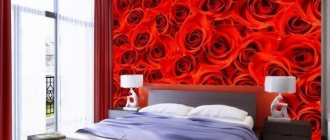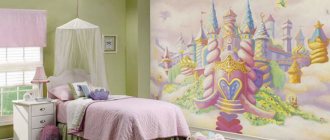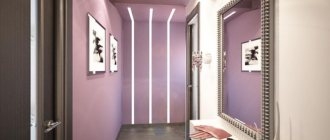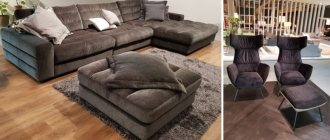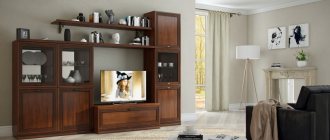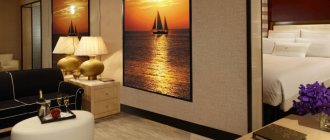Basic rules for combining
Having decided to hang combined wallpaper for the living room, many people forget about choosing an accent wall, the area of the room, and the features of a particular type of wallpaper.
Attempts to do it on a whim often result in an unattractive design, which can also be facilitated by a lack of experience in gluing.
There are only 4 rules and they are enough to successfully cope with the task:
- You always need to start from the area. Although dark gray is in fashion now, it is contraindicated for small rooms! Dark shades only reduce the area of the room, so in small living rooms only light wallpaper is suitable. In large halls, on the contrary, the tone should be dark. Otherwise the room will seem uncomfortable.
- Volumetric textures. Similar to the previous rule. Their three-dimensional effect will begin to press immediately and the small hall will seem microscopic. Living in it will be uncomfortable. In large rooms there is no such problem.
- Sun side. The combination of wallpaper in the living room requires taking into account lighting. If the apartment is located on the sunny side, then dark canvases are suitable opposite the window and vice versa.
- Horizontal and vertical. If you are lucky with the height of the ceilings, then you should not take a vertical pattern. This will make the room seem even higher, which is not very good. Nowadays correct geometry, both physical and visual, is in fashion. Horizontal stripes only make the room look longer.
Combination errors
The options for combining wallpaper for the living room in an apartment are varied, which causes even designers to make fatal mistakes. It is important to consider that the room does not consist only of walls, it also contains equipment, furniture, and decorations. Therefore, in addition to the rules, you also need to take into account:
- Furniture arrangement. If the wallpaper is a companion wallpaper in the interior with a texture, and the main wallpaper is plain, it is forbidden to block the former with furniture. This accent mistake is very common when for some reason a decorative wall is covered with a wall or a set.
- Multicolor. Large rooms are convenient because even 6 different colors are allowed and it will look normal. In small rooms there should not be more than 3 shades. Otherwise, the volume of the room will simply be lost and it will be difficult to feel it.
- Wallpaper with patterns in long rooms. If the living room is long and narrow, then textured canvases should be on small walls. Otherwise it will be even narrower and even longer.
- Pattern direction. If the room is low, the horizontal direction of the pattern (not necessarily stripes) will make it visually lower.
Criteria for choosing combined wallpaper for the living room
When combining wallpaper, it is very important to choose the right color scheme. Preliminary preparation and study of the issue of combination and color combination will help to decorate the surfaces stylishly and brightly. It should also be remembered that wallpaper and its combination should not distract from the main interior, the arrangement of furniture and decor.
When choosing the color of wallpaper, it is important to remember that tone and shade affect not only the design of the room and its visual perception, but also the psychological state of the people in the room.
Using wallpaper of different colors and textures, you can place accents and conveniently zone the room. Wallpaper can be smooth or embossed, multi-colored or plain. Before wallpapering, it is important to visually imagine the future appearance of the room and the overall interior.
Related article: Decorating the interior: Autumn crafts made from straw (38 photos)
When combining wallpaper, it is very important to choose the right color scheme.
Criterias of choice:
- Color;
- Tone;
- Texture;
- Material;
- Ornament.
Experts advise choosing wallpaper at the same time as choosing furniture and interior items. You can also start selecting combinations after purchasing the main interior items. It is important to be able to play with contrast, combine different textures and materials. The interior should be organic. It is important to take into account the features of the room, its lighting, size and geometry.
Popular combination methods
Now we know the rules of how to combine two types of wallpaper in a living room. This is already enough to make a simple design. But you can take the simple route and use ready-made templates developed by professional designers.
Shades of the same color
This combination of wallpaper is also called monochrome. Perhaps it is the simplest and should be chosen by those who want a calm but interesting design.
The combination of wallpaper in the interior is based on the fact that we take a primary color (for example, blue) and an additional color (indigo, sapphire, ultramarine, cobalt). That's all! They will be combined in any case and you won’t be able to make any mistakes here. But, it is desirable that at least one wallpaper have a pattern. Otherwise the room will be too oppressive.
Before combining wallpaper, it is better to look for large stores. Often they sell canvases from the same collection that are specifically designed for such a combination. It will be easier and more interesting this way.
Contrast
A very effective, but risky way. Contrasting combinations of double wallpaper in a living room is a delicate matter and requires knowledge of at least a banal complementary combination technology. For example, blue and yellow wallpaper is a good option, red and green too.
But here it is important to play with shades and patterns to make the room comfortable.
In addition, the contrasting combination can be divided into 3 subgroups:
- Simple. Combines 2 unidirectional colors. For example, pastel (any colors can be combined with each other) or black and white (extreme opposites).
- Average. Wallpapers, in principle, do not combine with each other, but they can be completed within a single interior.
- Complex. A combination of incompatible shades. It is the most difficult to execute, but many designers know how to correctly set contrasts.
Good photo examples of companion wallpaper for the living room can be seen below. Relying on them, you will be able to avoid the simplest mistakes.
Combination by gluing method
How to hang two types of wallpaper differently? There are 3 ideas on how to glue combined wallpaper in a living room:
- Vertical and horizontal alternation. In the first case, the wallpaper replaces each other after a certain period. In the case of horizontal alternation, the wall is divided into halves by a line. Canvases of one pattern and color are glued on top, and another on the bottom.
- A game of contrast. Contrasting pasting of a small section of wallpaper is quite a good method. In this case, by the way, expensive wallpaper with a high-quality silk-screened pattern is often used.
- Photo wallpaper. They are sold on a large canvas, and it is better to frame them with a frame made of molding or border.
You can see a photo of a combination of wallpaper of two colors in the living room below.
Game of textures
Paired textured wallpapers in one room are the most difficult to combine. The problem is that all canvases have different thicknesses. Even if it is only half a millimeter, the difference will be visible immediately. Therefore, you need to immediately find out their thickness.
Naturally, the colors should be related. Since we are experimenting with texture, there is no point in playing with shades.
It is also worth remembering the rule: paper wallpaper - with paper wallpaper; textile - with textile. You shouldn’t combine them together, if only because they have different densities and thicknesses. It will be extremely difficult to join them correctly.
You can see a photo of the living room with a textured combination below.
Combination of wallpaper of two colors: photo in the living room
Wall decoration is not only a decorative decoration of a room. Many designers use a combination of wallpaper of several colors in order to correct deficiencies in the geometry and lighting of the room. The combination of two colors will allow you to successfully zone the room and correctly place accents.
An effective technique for playing with light is to combine wallpaper in dark and light shades. This technique allows you to successfully cope with the design of a poorly lit room.
When decorating a room, it is important to pay attention to places that attract attention, as well as to inconspicuous areas. For finishing the latter, wallpaper in dark, calm shades is suitable. The rest of the room is decorated in light colors.
A combination of wallpaper of two colors will allow you to correctly place accents in the room.
How to choose the right color:
- Red . For a combination, gray, green, golden, blue are suitable. Purple, brick, brown, chestnut will look bad.
- Pink . For a combination, burgundy, brown, gray are suitable. It will not go well with turquoise, red and blue.
- Orange . Suitable combinations include green, purple, and white. Doesn't go well with red.
- Brown . Beige, blue, gray, gold are suitable for the combination. Cannot be combined with pink, lilac and burgundy.
- Yellow . Pairs well with green and brown. It will look bad with pink and burgundy.
When choosing a color, it is very important to take into account its effect on the human nervous system and the personal preferences of the apartment owners. On the Internet you can find many examples of combinations of both similar and contrasting colors. You should also take into account the level of illumination in the room - you need to be able to use the play of light and color.
Other wallpaper combination ideas
Save time: selected articles delivered to your inbox every week
There are no publications on the topic.
Features of wallpaper combinations in the living room: ideas and photos
Knowing how to combine wallpaper, it is important to be able to choose the right color and texture, shades, patterns and ornaments. When buying plain wallpaper, it is important to pay attention to its texture - it should vary. Wallpaper on the walls and ceiling can have the same motifs, which will create a harmonious and cozy atmosphere in the room.
It is important to remember that wallpaper can be the same or different shades - what is important here is not the difference or sameness of shades, but their harmonious combination.
An interesting technique is to decorate each wall in its own shade. It is worth remembering that the finish must be balanced. When choosing different designs, it is important to ensure that they are similar in type.
The living room should have a harmonious combination of wallpaper
What to pay attention to:
- Range;
- Balance;
- Duet;
- Contrast;
- Texture.
Real wallpaper combinations allow you to realize the most daring design ideas. The right combination can hide the imperfections of a room. Another important function of combination is space zoning.
What can wallpaper do for the living room?
It is difficult to argue that wallpaper for the living room should meet fashion trends. But they also have other purposes.
The most popular wall finishing material is capable of:
- visually change the ceiling height,
- visually expand the space,
- zone the room,
- hide minor surface defects.
These effects are achieved through texture and pattern. The color of the wallpaper for the living room is no less important. It should be selected based on the characteristics of the room, furniture and design style to which the entire room will be subject. For example, glass wallpaper in cold colors is not appropriate in the classic design of a small room. But they look great on large walls in a modern finish.
Combination options
In addition to the choice of structures, colors and patterns when using companions, you should pay attention to the decoration of the walls in terms of the volume of the background canvas and the bright one. In this case there are also a few simple rules.
- One surface is decorated with a bright canvas, the other three – with a background one. This solution is often used in a children's room.
- Alternating wallpaper in stripes. They can be the same or different thicknesses.
Bright design of the main areas of the children's room
- Horizontal zoning. This technique can be found often; it involves covering the walls in the lower part with dark canvases or those that have a large pattern. On top, light wallpaper or with a small print is used. The joints should be decorated with a border or molding, since it will definitely not be possible to make it perfectly even. This technique is often used when it is necessary to visually adjust a room. So, for a room with high ceilings, a dark background can occupy 1.5-2 m from the floor, and if the ceiling is standard or low, then no more than 1 m. This solution can be found in the Provence style.
Original wall decoration in the nursery
- Inserts – this option is relatively easy to implement. After all, the first thing to do is paste the background wallpaper, and on top of it a bright companion. Moreover, the latter should be really catchy and noticeable, with a clear relief. To make the inserts look organic, they are edged with frames made of wooden slats. This solution is typical for classic interiors.
Proper combination of materials with the use of borders
- The patchwork method is original, but difficult to implement. In this case, there will be some kind of patchwork on the walls, but from wallpaper. Often, companions are placed in a checkerboard pattern to create a certain systematicity. In this case, individual elements must simultaneously be contrasting, but at the same time harmonize well with each other.
Stylish bedroom decorated in patchwork style
Note! When choosing pairs or triplets of wallpaper, it is worth considering that contrasts visually make the room smaller. Therefore, for small rooms you need to use companions with and without patterns, but not flashy combinations.
Influence on the choice of cardinal directions
Any palette can manifest itself differently depending on the degree of natural light. This factor depends not only on the size of the window openings and their openness, but on the side of the world from which the room is located.
- South. Often there is not only enough sunlight, but also in excess. In order to reduce the “temperature”, it is recommended to use moderately cool shades (white, blue, turquoise, gray).
- West. During the daytime peaks, the room may be too hot and light, so there should be cool shades, such as mint (closer to blue), deep blue, gray, brown.
- East. It is recommended to give preference to pink and brown tones, which will benefit from the sunrise and compensate for its lack in the afternoon.
- North. Due to the coldness and short duration of sun hours, you need to choose warm, soft shades (beige, coffee, green, yellow). They will not only add light to the room, but also visually fill it with sun.
Before choosing the color of the walls for the living room, you need to consider the location and intensity of the lighting fixtures. If they are located around the entire perimeter of the room (in the form of LEDs or built-in lamps), the tint palette can be changed depending on the desired effect.
Design of adjacent and opposite walls
Decorating adjacent walls of the hall interiors using a combination technique is necessary when it is intended to use a corner sofa in the living room interior. For this, the solution shown in the photo can be chosen.
This combination has a number of operational advantages.
- Firstly, such bright accents set the tone for a certain dynamic. Softer combinations, such as those shown in the bottom photo, on the contrary, reduce the degree of activity and create increased comfort in the interior.
- Secondly, using a combination of different colors, it is easy to visually expand the space, lengthen the length of the walls, raise the height of the ceilings, make the room fill with air, or, conversely, turn it into a small cozy box.
- Thirdly, a combination of wallpaper of different textures helps to mask the shortcomings of the hall, change the irregular shape of the living room, and focus on niches or ledges.
The described technique is often used to save on the purchase of expensive rolls. It is well known that large stores give huge discounts on leftovers. A detailed study of existing examples and photos printed in this article will help you combine them. Such examples are a unique visual book that helps you master the basics of color combinations used in the design of living room rooms. And the next section will easily become a reference book for those who dream of receiving instructions for implementing ready-made projects.


